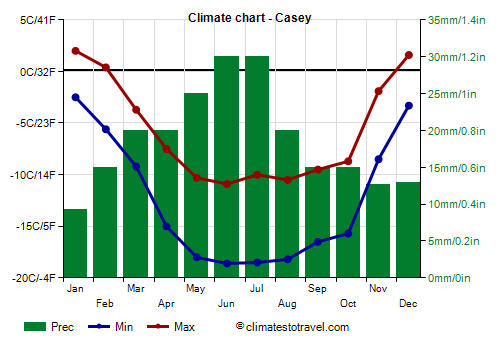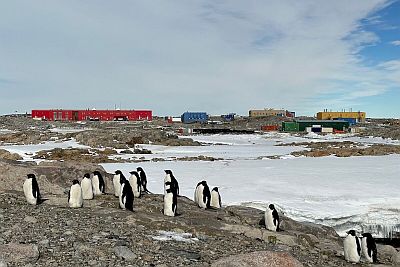Select units of measurement for the temperature and rainfall tables (metric or imperial).
Average weather, temperature, rainfall, sunshine hours

At the permanent base Casey, belonging to Australia, there is a
polar climate, with temperatures on average below freezing almost all year round. In summer, in December and January, the daily averages approach the freezing poiny, and average highs exceed this value.
The station is located on the coast of Antarctica, about 3,500 kilometers (2,175 miles) south of Australia, at 66 degrees south latitude (the same, on the other side of the world, as northern Iceland), just north of the Antarctic Circle. Nearby is the Wilkes station, built by the Americans in 1959 and now abandoned.
We are in
Wilkes Land, the area of the continent on the edge of the East Antarctic plateau, where the coldest areas in the world are found.
The only vegetation around Casey station is made up of mosses and lichens, while the fauna includes species such as penguins and seals, as well as migratory birds.

To the south-east of the station is the so-called
Law Dome, a dome-shaped ice cap that reaches almost 1,400 metres (4,600 ft).
The
katabatic winds blow from inland areas, and can sometimes reach hurricane force. The maximum gust was recorded on September 29, 1971, with 291 kph (180 mph).
While in summer the
temperatures are quite stable, in winter, from May to September, they fluctuate a lot. In fact, sometimes the currents from the ocean prevail, and the temperature can approach and even slightly exceed the freezing point even in the coldest months, while in other periods, currents from inland areas can bring
periods of intense cold, down to -30 °C (-22 °F) or even below. The record is -38 °C (-36.5 °F), set in July 1976 and July 1986. After 2000, the record is -37.5 °C (-35.5 °F), set in August 2005.
In December and January, on the other hand, the highest records are of 8/9 °C (46/48 °F).
Here are the average temperatures.
Casey - Average temperatures (2000-2020) |
| Month | Min | Max | Mean |
|---|
| January | -2.5 | 2 | -0.2 |
|---|
| February | -5.6 | 0.4 | -2.6 |
|---|
| March | -9.2 | -3.7 | -6.4 |
|---|
| April | -15 | -7.5 | -11.2 |
|---|
| May | -18 | -10.3 | -14.2 |
|---|
| June | -18.6 | -10.9 | -14.8 |
|---|
| July | -18.5 | -10 | -14.2 |
|---|
| August | -18.2 | -10.5 | -14.4 |
|---|
| September | -16.5 | -9.5 | -13 |
|---|
| October | -15.7 | -8.7 | -12.2 |
|---|
| November | -8.5 | -1.9 | -5.2 |
|---|
| December | -3.3 | 1.6 | -0.8 |
|---|
| Year | -12.5 | -5.8 | -9.1 |
|---|
is scarce, just 222 millimeters (8.7 inches) per year, and almost all occurs in the form of
snow or sleet. However, sometimes, from December to February, it can also rain. Snowfall is frequent but generally light.
Here is the average precipitation.
Casey - Average precipitation| Month | Days |
|---|
| January | 9 | 7 |
|---|
| February | 15 | 8 |
|---|
| March | 20 | 9 |
|---|
| April | 20 | 9 |
|---|
| May | 25 | 10 |
|---|
| June | 30 | 11 |
|---|
| July | 30 | 10 |
|---|
| August | 20 | 8 |
|---|
| September | 15 | 9 |
|---|
| October | 15 | 8 |
|---|
| November | 13 | 6 |
|---|
| December | 13 | 6 |
|---|
| Year | 225 | 101 |
|---|
The amount of
sunshine at Casey Station is very low, approximately 1,150 hours per year. The sunniest month is November, the last month of spring.
Here are the average sunshine hours per day.
Casey - Sunshine hours| Month | Average | Total |
|---|
| January | 5 | 160 |
|---|
| February | 5 | 135 |
|---|
| March | 3 | 100 |
|---|
| April | 2 | 60 |
|---|
| May | 0.5 | 20 |
|---|
| June | 0 | 5 |
|---|
| July | 0.5 | 10 |
|---|
| August | 1.5 | 45 |
|---|
| September | 3 | 85 |
|---|
| October | 4.5 | 140 |
|---|
| November | 7 | 215 |
|---|
| December | 6 | 185 |
|---|
| Year | 3.2 | 1160 |
|---|
Since it is located north of the polar circle, Casey Station does not experience the
polar nights. However, from late May to mid-July, the day lasts less than 4 hours, and at the winter solstice, June 21st or 22nd depending on the year, it lasts just under two and a half hours.
Instead, due to the refraction of the atmosphere, the
polar day, in which the sun never sets, occurs in summer from December 10th to January 3rd. For a few weeks, before and after this period, the sun remains close to the horizon even at midnight, providing some light, so the so-called "white nights" occur.
At the summer solstice, December 21st or 22nd, at midday the sun reaches 47 degrees above the horizon, that is, twice as high as the South Pole.
Casey - Climate data
In Casey, the
average temperature of the coldest month (June) is of
-14.8 °C, that of the warmest month (January) is of
-0.2 °C. Here are the average temperatures.
Casey - Average temperatures (2000-2020) |
| Month | Min | Max | Mean |
|---|
| January | -2.5 | 2 | -0.2 |
|---|
| February | -5.6 | 0.4 | -2.6 |
|---|
| March | -9.2 | -3.7 | -6.4 |
|---|
| April | -15 | -7.5 | -11.2 |
|---|
| May | -18 | -10.3 | -14.2 |
|---|
| June | -18.6 | -10.9 | -14.8 |
|---|
| July | -18.5 | -10 | -14.2 |
|---|
| August | -18.2 | -10.5 | -14.4 |
|---|
| September | -16.5 | -9.5 | -13 |
|---|
| October | -15.7 | -8.7 | -12.2 |
|---|
| November | -8.5 | -1.9 | -5.2 |
|---|
| December | -3.3 | 1.6 | -0.8 |
|---|
| Year | -12.5 | -5.8 | -9.1 |
|---|
amounts to
225 millimeters per year: it is therefore scarce. It ranges from
9.3 millimeters in the driest month (January) to
30 millimeters in the wettest ones (June, July) Here is the average precipitation.
Casey - Average precipitation| Month | Days |
|---|
| January | 9 | 7 |
|---|
| February | 15 | 8 |
|---|
| March | 20 | 9 |
|---|
| April | 20 | 9 |
|---|
| May | 25 | 10 |
|---|
| June | 30 | 11 |
|---|
| July | 30 | 10 |
|---|
| August | 20 | 8 |
|---|
| September | 15 | 9 |
|---|
| October | 15 | 8 |
|---|
| November | 13 | 6 |
|---|
| December | 13 | 6 |
|---|
| Year | 225 | 101 |
|---|
There are on average around 1160
sunshine hours per year. Here are the average hours of sunshine per day.
Casey - Sunshine hours| Month | Average | Total |
|---|
| January | 5 | 160 |
|---|
| February | 5 | 135 |
|---|
| March | 3 | 100 |
|---|
| April | 2 | 60 |
|---|
| May | 0.5 | 20 |
|---|
| June | 0 | 5 |
|---|
| July | 0.5 | 10 |
|---|
| August | 1.5 | 45 |
|---|
| September | 3 | 85 |
|---|
| October | 4.5 | 140 |
|---|
| November | 7 | 215 |
|---|
| December | 6 | 185 |
|---|
| Year | 3.2 | 1160 |
|---|